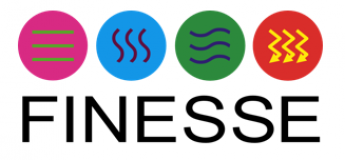Objectives: This WP will focus on the development of new interrogation architectures that will give rise to a new generation of distributed sensors capable of overcoming current limitations in some of the present-day architectures.
Description of Work and Role of Specific Beneficiaries / Partner Organisations
DOFS systems are currently successful in applications where the structure to be monitored spans a few kilometres, the resolution required is not below a few meters and the monitoring is static or quasi-static. Typical applications include pipeline leakage monitoring, integrity monitoring of large civil structures, roads, railways, etc. There are some applications where a radically different set of specifications are required on the sensor. As an example, millimetre scale resolutions over short or long distances are sometimes required (e.g. crack monitoring, curvature sensing), dynamic true-strain interrogation is demanded (e.g. in avionic applications), access to multiple parameters on the same fibre, single-shot measurements, etc. For these application niches, there is so far no solution. The demand for extending current distributed sensing systems to these new performance areas is increasing, and the FINESSE consortium aims at contributing to this trend by addressing five major challenges, each one concerning a specific technology in this WP:
- Ultra-weak and ultra-long fibre Faint Long Optical Gratings (FLOGs), which can potentially massively outperform existing distributed fibre sensing solutions, in terms of accuracy and response signal thanks to their ideal back-coupling efficiency and their best intrinsic sensitivity. This will globally upscale performance provided that a technological solution can be implemented to fabricate FLOGs in a mass production approach. ESR 1 will demonstrate a FLOG distributed fibre sensor: the interrogation system will be realised at EPFL, complemented by training at TAU; FLOG inscription at UPVLC (phase mask) and IPHT (draw tower level) and the final system developed at Omnisens.
- Birefringence-based distributed fibre sensor, which is primarily designed to combine the advantages of Brillouin- and Rayleigh-based sensors (absolute measurement of temperature with a 0.1K accuracy over 1km and a sub-metric spatial resolution) to bring to the market a sensor offering a significant bonus in terms of performance and handling, at equal costs. Moreover, birefringence is linearly sensitive other quantities not accessible with classical techniques such as hydrostatic pressure, which can modify the value of birefringence in specially-designed fibres that will be developed by ESR 6 in WP2. This work will be performed by ESR 2 at EPFL (interrogation methods) with collaborations from UAH (phase-OTDR techniques), VUB (fibre design, application for distributed pressure measurement), PERFOS (fibre fabrication), ACREO (applications for E-field measurement) and Omnisens (feasibility of product development).
- Fast and distributed Brillouin Optical time Domain Analysis (BOTDA) techniques, allowing the dynamic interrogation of strain at 100’s of Hz sampling speed and 100’s of meters sensing range. The approach will be based on proven basic ideas of slope assisted and fast frequency scanning techniques, with the additional aim of being able to differentiate between strain and temperature. ESR 3 will work on this research programme, led by TAU (slope assisted and fast distributed interrogation techniques) with collaborations from UAH (fast polarization noise mitigation techniques) and EPFL (harnessing non-linearities in BOTDA). Collaboration with the company FAST-laser will attempt to bring this type of interrogation system one-step closer to the market.
- Novel, phase-sensitive Optical Time Domain Reflectometry (phase-OTDR)-based techniques for distributed gas sensing method. ESR 4 will concentrate on interrogation methods (UAH), optimised fibre designs (VUB) and fabrication (IPHT) for the development of a distributed gas sensing system (FOCUS), which has had so far little development due to several constraints, among them the need of performing the sensing at the specific absorption wavelengths of the different gas species. Field test will be done with FLUVES.
Advanced signal processing methods in phase-OTDR systems, enabling quantitative recovery of strain and temperature along a fibre in a fully dynamic way (using single-shot data). ESR 5 will focus his/her work at UAH (complex phase-OTDR interrogation methods), with collaboration from EPFL (harnessing nonlinearities in phase-OTDR) and FOCUS (feasibility of application in real commercial systems). Exploration on the use of phase-recovery methods for copper cable theft detection in railway infrastructure will be tested at ADIF.
